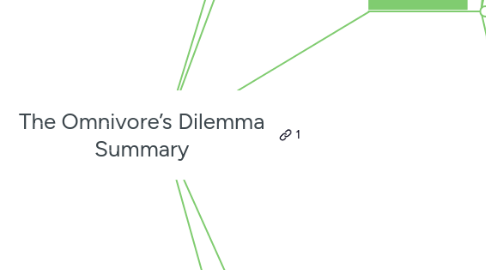
1. 1-Sentence-Summary:
1.1. The Omnivore’s Dilemma explains the paradox of food choices we face today, how the industrial revolution changed the way we eat and see food today and which food choices are the most ethical, sustainable and environmentally friendly.
2. Favorite quote from the author:
2.1. "Don't eat anything your great-grandmother wouldn't recognize as food." - Michael Pollan
3. 3 lessons:
3.1. It all started with corn.
3.1.1. In theory, corn is a great plant.
3.1.1.1. It’s highly adaptable, very resistant, and grows in large quantities fast.
3.1.1.2. When the Europeans first landed in the US and discovered it, it quickly became a household name for farmers.
3.1.2. But you can overdo even the best thing.
3.1.2.1. Technology has advanced so far that we can now alter plants at the genetic level, and the corn industrial farmers grow now has little to do with its ancestor.
3.1.2.2. In 1920 a farmer could comfortably produce 20 bushels of corn per acre. That figure has shot to 180 today – a 9x increase!
3.1.2.3. 10 years ago, it cost a farmer $2.50 to produce a bushel, but due to the already flooded market, buyers only wanted to pay $1.45.
3.1.2.4. When the government agreed to match the difference, and thus gave the farmers an artificial profit for producing corn, it ruined the supply and demand cycle of corn.
3.1.2.5. Farmers can make a ton of money from producing corn and continue to grow more and more, even though the market’s demand has long been saturated.
3.1.2.6. The excess corn is what lands in your food in the form of high fructose corn syrup and other highly processed derivatives, and is fed to all kinds of animals, who aren’t natural corn eaters, like cows, chicken and even carnivore’s like salmon.
3.2. Organic is not as clean as you think it is.
3.2.1. The whole processed food industry is not the greenest choice you can make.
3.2.2. But what about organic food?
3.2.2.1. Originally started as a counter-movement to processed and industrialized food, due to its popularity, organic food as a label has been swept up by the processed food lobby.
3.2.2.2. Plenty of the small farms that came from the organic movement had to either let go of some of their standards in order to supply the growing demand for organic food, or go out of business.
3.2.2.3. As organic businesses grew, standards were lowered, and now food companies can cut corners and still get away with labels like “organic” and “free-range”.
3.2.2.4. For example, would you call 20,000 chickens in a shed with a two-week mini vacation in the tiny back yard free-range?
3.2.2.4.1. The food industry would.
3.2.2.5. “Organic high fructose corn syrup” is one of the most artificial things ever produced.
3.3. If you buy locally, you win on all levels.
3.3.1. Get your food from small, local farms, and everyone will win, including you.
3.3.2. Here are the reasons why:
3.3.2.1. Due to the reduction in distance that your food travels until it eventually lands on your plate, less fuel and resources are used, making this the environmentally friendlier alternative.
3.3.2.2. Economically, you put money into the hands of the right people: small businesses.
3.3.2.2.1. As long as we give the majority of our money to big corporations, they’ll be the ones in charge.
3.3.2.3. The quality of your food is increased, because it’s grown in according to the season and natural circumstances on site, which makes pesticides and other artificial support unnecessary.
3.3.2.4. Ethically, this is a no brainer, and it also holds your farmer, butcher and baker accountable.
3.3.2.4.1. When they know you’re passing by their store every day, they’re much less likely to mistreat animals or plants, because of their personal relationship with you.
3.3.3. So start by skipping the supermarket once in a while and look at the options right in front of you.
